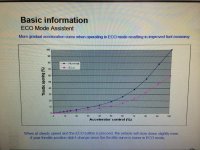ECO Mode info
What is it? Have heard it is just a when to shift mode or a different driving mode. Which is it?
SHIFTING SUGGESTIONS:
(The shifting-point suggestions for the 1330 and 900 series engines are explained separately.)
Shifting the 1330 models:
The “ECO” mode shift coach suggests shifting at the following rpm’s:
1st to 2nd: 1,800 rpm’s
2nd to 3rd: 1,950 rpm’s
3rd and up: 2,200 rpm’s
When manually shifting the 1330, it seems too many are over thinking it. If you are not using the ECO-mode, then just shift at around 2500-3000 rpm’s. That shift-point falls right at the beginning of the first-level power band, which is perfect. (Funny how that seems to work! See below.)
1330 Engine Power Band (Dyno-Chart Data):
1st level power band begins at approximately 2,500 — 2,700 rpm’s and remains flat until 4,000 rpm’s.
2nd level power band begins at approximately 4,500 — 4,700 rpm’s and peaks at 5,000 rpm’s.
After 5,000 rpm’s the power declines slightly until reaching 6,000 rpm’s; where the power rapidly declines; thus proving any increase in rpm’s above 6,000 rpm’s on the 1300 is inefficient and fruitless with regard to obtaining additional power and torque.
What does this mean?
It means shifting below 2,500 rpm’s can put an extra load on the machine when accelerating above a relaxed pace. While it may appear the engine has plenty of power below 2,500, it, in fact, is not producing peak performance power at that point, thus, shifting below the power band makes the engine work a bit harder. While the manual suggests shifting below 2,500 rpm’s, it is doing so with the thought the operator is accelerating at a very relaxed pace.
Some have a misperception with regard to shifting a machine within its peak power band. It is often perceived to require harder/faster acceleration; when, in fact, that is not the case.
It simply means you hold the machine in a gear longer before shifting. One does not have to takeoff from a dead stop like a drag racer to shift within a vehicle’s power band. Again, you simply hold it in each gear for a bit longer until the rpm’s reach the power band.
American’s have long been known to have a preference to low-torque machines. With that often comes the tendency to want to shift to a vehicle’s highest gear as soon as possible, and leave it there… at least until the engine begins to shake and shudder. Not a good idea with any vehicle.
Why is this important?
Over a short period of time and mileage, there would probably be little noticeable affect or damage to a machine operated below its power band under normal, relaxed conditions; however, over a longer-term, there certainly can be a excessive wear along the machine’s drivetrain.
In addition to seeking peak vehicle performance, expert/professional drivers & riders always operate their machines within its power band at all times for added control and handling. Consider it a safety precaution.
Any vehicle operated outside of its peak performance band is operated with some loss of control and efficiency — varying, of course, to the degree it is operated out of its power band.
For most owners of the 1330 engine, its lower torque seems to satisfy the inherent American “need” for an engine operating at a lower rpm.
NOTE: There is NOT a “Trailer Mode” for the 1300 model.
1330 "ECO" Shifting Check your manual)
Check your manual) (Provided by PMK)
The ECO (fuel economy mode) setting reduces fuel consumption by limiting throttle response and maximum throttle opening to maintain an optimal cruising setting.
Activating the ECO Mode:
Press the "MODE" button for 2-seconds while in the Main Screen.
When activated, a green arrow will alternate with the gearbox position indicator to indicate the optimal timing to up-shift the transmission.
NOTE: The Gearbox indicator will return when the transmission is shifted.
De-Activating the ECO Mode:
Press the "MODE" button for 2-seconds while in the Main Screen.
ADDITIONAL INFORMATION: (provided by Lamonster) The throttle map changes to a more progressive acceleration; rather than a linear one. During hard acceleration there will not be an indication to shift -- the ECM understands you are accelerating and will not recommend a shift at this time. Only when the vehicle speed and acceleration have stabilized for a certain time and the ECM judges there is enough engine torque available in the next gear to keep the same speed and acceleration will an upshift indication be displayed.


